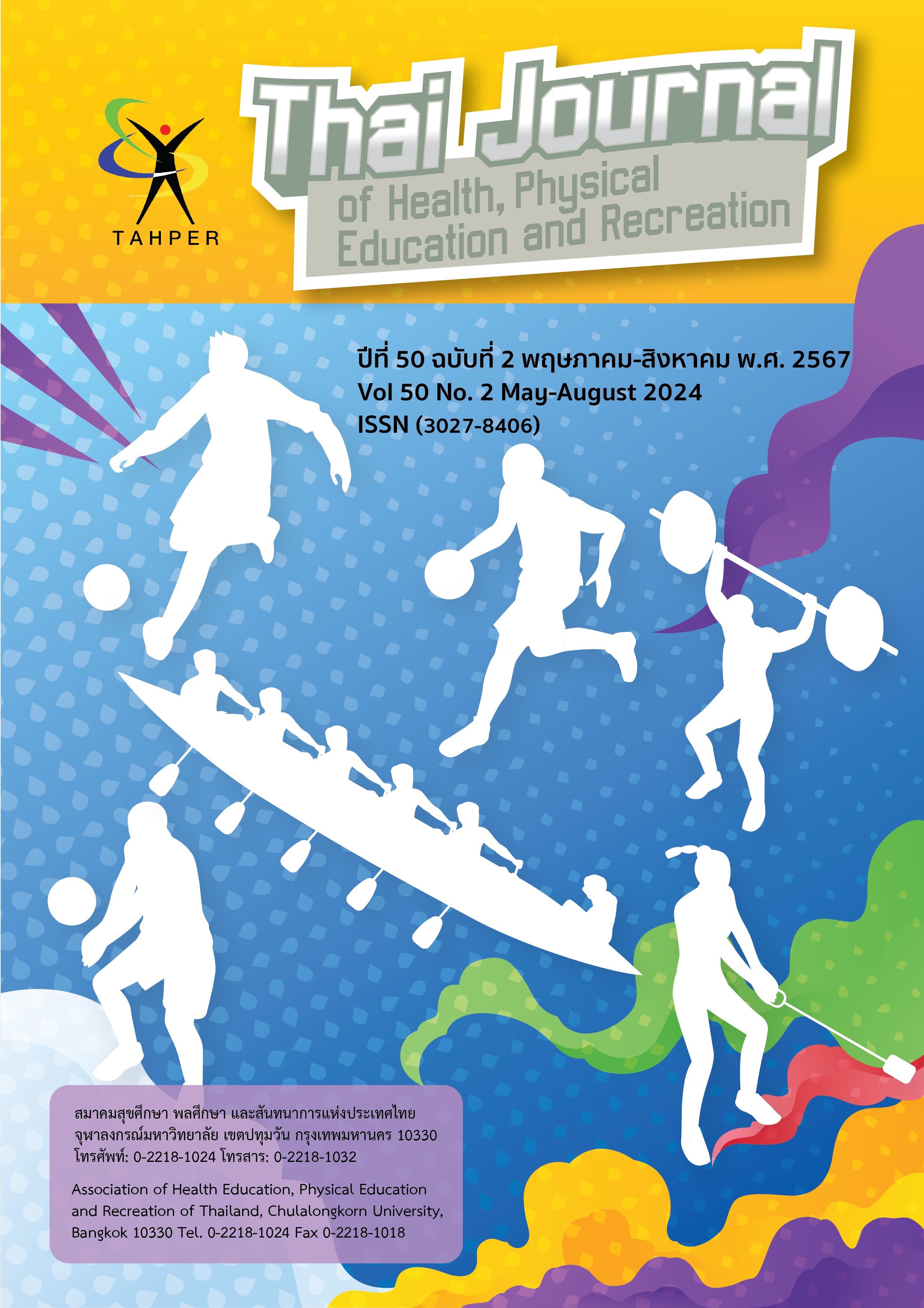Effects of the Manipulative Movement Training Program Through the Use of QR Code Technology on Agility of Grade 3 Students of Kasetsart University Laboratory School Center for Educational Research and Development
Main Article Content
Abstract
The purpose of this quasi - experimental research design was to study the effects of manipulative movement training program through the use of QR code technology on agility of grade 3 students of Kasetsart University Laboratory School Center for Educational Research and Development. The sample were 41 Grade 3 students who register in the first semester of the academic year 2020 at Kasetsart University Laboratory School Center for Educational REsearch and Development. The participants were obtained by cluster sampling method . The research instruments were the manipulative movement training program through the use of QR code technology created by the researcher and validated for face validity by 7 experts. And Physical fitness test for Thai children aged 7-18 years (Agility Test) created by Office of Sport Science, Department of Physical Education, Ministry of Tourism and Sports, 2012. The participants was trained for 8 weeks and the physical fitness was tested before training and after 8 weeks of training. The data were analyzed by mean, standard deviation and Paired Sample t – test.
The results showed that after 8 weeks of training with the manipulative movement training program through the use of QR code technology, the agility of participants increased statistically significance at the .05 level. In conclusion, the manipulative movement training program through the use of QR code technology constructed by the researcher was improved agility of grade 3 students of Kasetsart University Laboratory School Center for Educational Research and Development.
Article Details

This work is licensed under a Creative Commons Attribution-NonCommercial-NoDerivatives 4.0 International License.
Critical thinking in journals is the right of the author. The Association of Health Education, Physical Education and Recreation of Thailand is not always required, to create diversity in ideas and creativity.
ความคิด ข้อวิพากษ์ในวารสารเป้นสิทธิของผู้เขียน สมาคมสุขศึกษา พลศึกษา และสันทนาการแห่งประเทศไทยไม่จำเป็นต้องเห็นชอบด้วยเสมอไป เพื่อให้เกิดความหลากหลายในความคิดและความสร้างสรรค์
References
กรรวี บุญชัย. (2540). คิเนสิโอโลยีเบื้องต้น. กรุงเทพมหานคร: มหาวิทยาลัยเกษตรศาสตร์.
กระทรวงศึกษาธิการ. (2551). หลักสูตรแกนกลางการศึกษาขั้นพื้นฐาน พุทธศักราช 2551. กรุงเทพมหานคร: โรงพิมพ์ชุมนุมสหกรณ์การเกษตรแห่งประเทศไทย จำกัด.
กัตตกมล พิศแลงาม. (2561). การประยุกต์ใช้เทคโนโลยีรหัสคิวอาร์สำหรับการจัดการเรียนการสอนในรายวิชาภาษาการสื่อสาร และเทคโนโลยีสารสนเทศ ของหมวดวิชาศึกษาทั่วไป. การประชุมวิชาการระดับชาติ ด้านนวัตกรรมเพื่อการเรียนรู้และสิ่งประดิษฐ์ ครั้งที่ 2 ประจำปี 2561 ฉบับวันที่ 18 กรกฎาคม 2561 ณ มหาวิทยาลัยเทคโนโลยีราชมงคลธัญบุรี จังหวัดปทุมธานี.
จิรากรณ์ ศิริประเสริฐ. (2543). ทักษะและเทคนิคการสอนพลศึกษาในระดับประถมศึกษา.กรุงเทพมหานคร: สำนักพิมพ์แห่งจุฬาลงกรณ์มหาวิทยาลัย.
เจริญ กระบวนรัตน์. (2557). วิทยาศาสตร์การฝึกสอนกีฬา. กรุงเทพฯ: บริษัท สินธนาก๊อปปี้เซนเตอร์ จำกัด.
______. (2552). ตาราง 9 ช่อง กับการพัฒนาสมอง. กรุงเทพมหานคร: โรงพิมพ์บริษัทสินธนา ก๊อปปี้ เซ็นเตอร์.
______. (2545). หลักการและเทคนิคการฝึกกรีฑา. กรุงเทพฯ: มหาวิทยาลัยเกษตรศาสตร์.
ชูศักดิ์ เวชแพศย์ , กันยา ปาละวิวัธน์. (2540). สรีรวิทยาของการออกกำลังกาย. พิมพ์ครั้งที่ 1. กรุงเทพฯ : ธรรกมลการพิมพ์.
ถนอมวงศ์ กฤษณ์เพ็ชร์. (2552). สร้างเด็กไทยให้เต็มศักยภาพด้วยการออกกำลังกาย. กรุงเทพมหานคร: สำนักงานคณะกรรมการพัฒนาการเศรษฐกิจและสังคมแห่งชาติ.
ไพวัน เพลิดพราว. (2559). การเคลื่อนไหวเบื้องต้น (Basic Movement). คณะศึกษาศาสตร์ สถาบันการพลศึกษา วิทยาเขตอุดรธานี . เอกสารประกอบการเรียนวิชาการเคลื่อนไหวเบื้องต้น.
วนัชพร ไกรราช. (2561). การประยุกต์ใช้เทคโนโลยีคิวอาร์โค้ดเพื่อส่งเสริมกิจกรรมการเรียนรู้สำหรับสวนพฤกษศาสตร์วิทยาลัยเกษตรและเทคโนโลยีพิจิตร. การศึกษาค้นคว้าด้วยตนเอง ปริญญาการศึกษามหาบัณฑิต สาขาวิชาเทคโนโลยีและสื่อสารการศึกษา, มหาวิทยาลัยนเรศวร.
วุฒิพงษ์ ปรมัตถากร , อารี ปรมัตถากร. (2537). วิทยาศาสตร์การกีฬา. กรุงเทพมหานคร: สำนักพิมพ์ไทยวัฒนาพานิช.
ศิริรัตน์ หิรัญรัตน์. (2539). กีฬาเวชศาสตร์พื้นฐาน. กรุงเทพมหานคร: จุฬาลงกรณ์มหาวิทยาลัย.
ศรีเรือน แก้วกังวาล. (2553). จิตวิทยาพัฒนาการชีวิตทุกช่วงวัย. พิมพ์ครั้งที่ 9. กรุงเทพมหานคร: สำนักพิมพ์มหาวิทยาลัยธรรมศาสตร์.
สมพล สงวนรังศิริกุล. (2546). ข้อแนะนำการออกกำลังกายสำหรับเด็ก (อายุ 2-12 ปี). นนทบุรี: กองออกกำลังกายเพื่อสุขภาพ กรมอนามัย กระทรวงสาธารณสุข.
สุชา จันทน์เอม. (2541). จิตวิทยาพัฒนาการ. กรุงเทพมหานคร: โรงพิมพ์ไทยวัฒนาพานิช.
สุพิตร สมาหิโต. (2541). การสร้างแบบทดสอบสมรรถภาพทางกายสำหรับเด็กไทยระดับ ประถมศึกษา. กรุงเทพ : มหาวิทยาลัยเกษตรศาสตร์.
______. (2541). แบบทดสอบสมรรถภาพทางกาย, (KASETSART Youth Fitness Test) ภาควิชาวิทยาศาสตร์การกีฬา คณะศึกษาศาสตร์ มหาวิทยาลัยเกษตรศาสตร์, กรุงเทพฯ.
สุรางค์ โค้วตระกูล. (2541). จิตวิทยาการศึกษา. กรุงเทพมหานคร: สำนักพิมพ์แห่งจุฬาลงกรณ์มหาวิทยาลัย.
Brien, W. O., S. Belton and J. Issartel. (2015). “Fundamental movement skill proficiency amongst adolescent youth.” Physical Education and Sport Pedagogy (Online). www.tandfonline.com/doi/pdf/10.1080/17408989.2015.1017451, June 12, 2016.
Buschner, C. A. (1994). Teaching Children Movement Concepts and Skill. Illinois: Human Kinetics.
Johnson, B. L., & Nelson, J. K. (1969). Practical Measurements for evaluation in physical education Kircher, G., Fishburne, G.J. (1995). Physical Education for Elementary School Children. Dubuque: Brow & Benehmark Publishes.
Pasand, F. et al. (2014). “Impact of Traditional Exercises on Perceptual-Motor Development in Elementary School Girl Students.” Indian Journal of Fundamental and Applied Life Sciences 4 (S3): 1297-1302.
Penny,G.D. (1970). A Study of Resistance Running on Speed, Strength Power,Muscular Endurance and Agtility. 31 , 3973-A.
Sanders, S. W. 1992. Designing Preschool Movement Programs. Illinois: Human Kinetics.


